Information to be Transferred and Its Format
Recording Appropriate Information and Selecting a Format for Achieving Traceability
The major premise of the implementation of tracing back and tracing forward is that appropriate information is recorded and saved in each process. You need to acquire not only product numbers and lot numbers but also place of production, expiration date, manufacturing date and time, inspection details, and ship-from/ship-to parties for every process.
Information to be Acquired for Traceability
The items of the information vary depending on the range of traceability such as industry, item and process. For the manufacturing industry, for instance, you will have ship-from party, manufacturing details, manufacturing date and time, inspection date and time, person in charge, production line, and ship-to party. For the food industry, you will have producer, place of production, shipped date and time, processed date and time, expiration date, and ship-to party.
Examples of information to be acquired
| Information about reception (acceptance record) | Information about manufacturing/processing (internal process record) | Information about shipment (shipment record) |
|---|---|---|
|
|
|
Rules on identification symbols
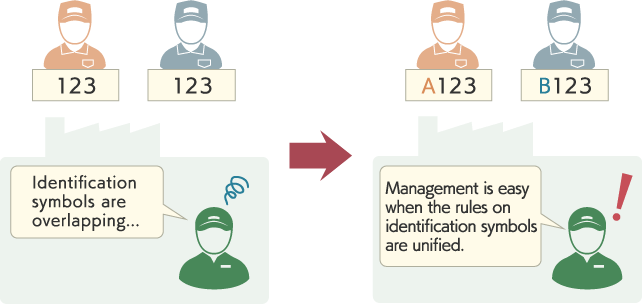
The first thing to do to deal with the information is to establish rules on identification symbols. If these rules are not observed and symbols overlap, information cannot be identified accurately, which prevents tracing forward and back. When parts are received from several suppliers or multiple companies are involved in the completion of a product, in particular, it is essential to establish a rule on identification symbols to be shared among those companies.
Representation Format and Transfer Medium (Storage Medium)
There are various types of identification symbols used for information transfer, including not only numbers and characters that can be recognized by human eye, but also barcodes, 2D codes, and electronic information. These symbols and representation methods used for transferring such information are called representation formats. The representation formats refer to just symbols such as characters or 2D codes. They should be used together with transfer media (storage media) such as labels or electronic tags used to indicate information on the parts and products.
For example, assume that you paste a label on a cardboard box which contains a received part. You are going to write the delivery date and product name by pen. In this case, the label is the transfer medium and the numbers and characters indicating the delivery date and product name are the representation format. If you write data directly on the cardboard box, the cardboard box is the transfer medium. If you inscribe data directly on the part with laser, the inscribed numbers/characters are the representation format and the transfer medium is "none" because it is the product itself.
Recording Medium
You can attach information on parts and products by using the representation format and transfer medium. To ensure traceability, however, you need to collect and manage serial numbers or lot numbers. Consequently, you need to receive the representation format from the transfer medium, collect that information and manage it somehow. Paper ledgers, personal computers, or a cloud servers can all be used for recording and management. In traceability, these are called recording media.
You collect and manage the information by writing it manually on a paper ledger, or by entering manually or reading and sending it with a code reader onto a PC or a server. After establishing rules to allow retrieval of the information as necessary, you can finally implement tracing forward/back.
Typical Combination of the Representation Format, Transfer Medium and Recording Medium
String of characters and numbers + Paper medium
Use numbers and characters that can be recognized by the human eye as the representation format and use labels or stickers as the transfer medium. For example, numbers such as 20XX0101 to show the expiration date, characters such as LOT000001 to represent a lot, and characters such as ABC0001 to represent a serial number. Paper media used for the transfer medium are divided into two types: those that are integrated with the product such as labels or package boxes; and those that are included with the product such as invoices or delivery slips. For the recording medium, some people use handwritten paper ledgers. Direct recording onto a PC with OCR (Optical Character Recognition)-capable handheld mobile computer is also becoming increasingly popular.
Barcode + Paper medium
Use barcodes as the representation format and print them by using labels or packaging boxes as the transfer medium. Since barcodes cannot be read with by the human eye, a code reader or other reading device is required. A printer and software are also needed to print barcodes onto labels or other transfer media. The recording medium is a computer, which allows easy information management, non-contact reading, and implementation at relatively low cost. This combination has been used in various industries from manufacturing to food, pharmaceutical and retail.
| Representation format | Transfer medium | Recording medium |
|---|---|---|
 |
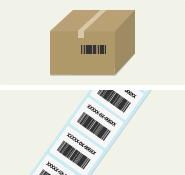 |
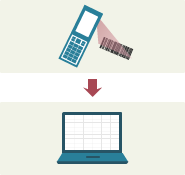 |
2D code and direct marking
The use of 2D codes as the representation format has been increasing in recent years. 2D codes allow you to pack more information into a smaller space. The reading accuracy is also improving. Direct part marking marks information directly on the parts. Since no transfer medium is required, you can save running cost.
| Representation format | Transfer medium | Recording medium |
|---|---|---|
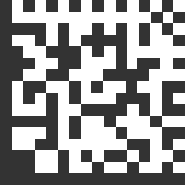 |
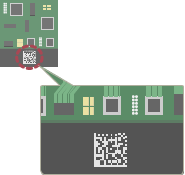 |
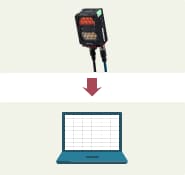 |
Electronic information and electronic tag (IC tag)
Electronic information is used as the representation format and small electronic tags (IC tags) are used as the transfer medium. Electronic tags communicate information via radio waves. It is advantageous that, within a specified area, the information even at a remote site can be acquired or the information of multiple electronic tags can be acquired simultaneously. The disadvantage is that electronic tags used as the transfer medium are expensive.
| Representation format | Transfer medium | Recording medium |
|---|---|---|
 |
 |
 |




